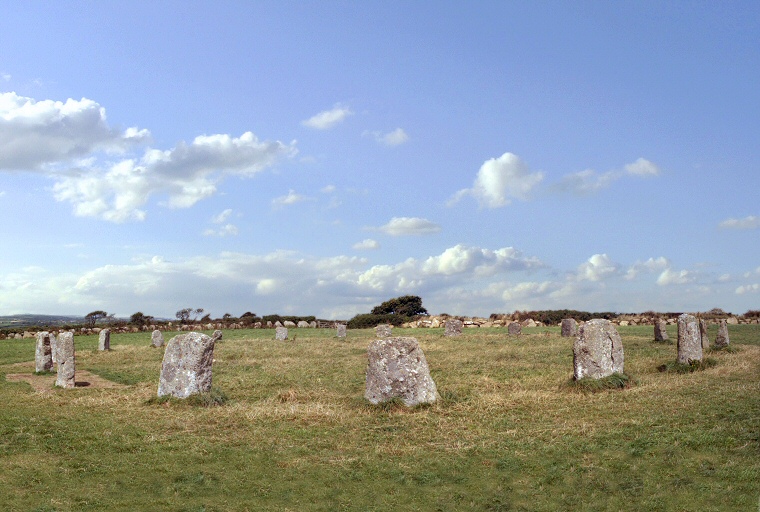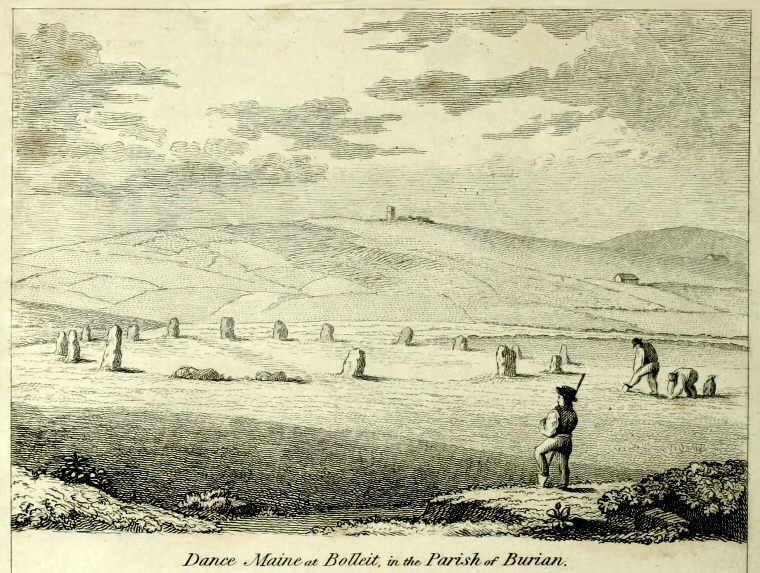
The Merry Maidens are probably the most well known, most accessible and most visited of the stone
circles on the western tip of
Cornwall. Although the circle is located less than a mile to the north of the cliffs at Boscawen Point and Tater Du the sea is not visible from the site, instead the stones sit on a gently north-western facing slope above a shallow valley whose streams meander the short distance to the sea at Lamorna Cove.
The picture postcard ring of stones consists of nineteen granite blocks set in an almost perfect circle of just under 24 metre diameter with a gap to the east marking an apparent entrance. The stones vary in height from about 0.9 metres to 1.4 metres and are graded so that the tallest of the original stones stand towards the southwest, the builders of the circle also took care to level the tops of the stones and oriented them so their smoother sides faced into the circle.
The circle is very similar in size and design to the more secluded Boscawen-un circle 2 miles (3.4 km) to the northwest, however while Boscawen-un has an associated standing stone within the circle itself, the Merry Maidens have theirs outside of the circle - a pair of massive monoliths known as The Pipers of Boleigh stand out of sight in a field to the northeast. A line drawn through these outliers would pass close to or even through the northern sector of the Merry Maidens and it is tempting to speculate that they may have formed route markers to the circle perhaps leading up from the valley floor somewhere below Boleigh Farm.
There are also two other stones associated with this site, and herein lies some confusion. Some sources quote The Fiddler, also known as Gûn Rith, just to the west of the circle at grid reference NG 429245, while others mention The Blind Fiddler, at least 2 miles to the north. Whichever it is, the legend attached to the stones is the same - the Maidens are a group of girls turned to stone for dancing past midnight on a Saturday and on into the Sabbath, while the Pipers and the Fiddler (be he the blind or sighted one) realising the time were similarly stricken as they fled the scene of such un-Christian goings-on. The legend also lends a descriptive alternate name to the circle - variously spelled as the Dans Maen, Dawns Mên or Dons Meyn (the Stone Dance or Dance of Stones) while the more prosaic Boleigh or Rosemodress Circle relates to names of nearby farms
The Merry Maidens were partly restored in the mid 19th century and whether the circle as it stands today is an accurate reconstruction of the original is not clear. The antiquarian William Borlase is said to have mistakenly reported nineteen stones at the site in the mid 18th century when in fact only eighteen stones were present, however a contemporary antiquarian William Stukeley sketched the site also showing it containing nineteen stones. In the early 19th century William Cotton sketched only eighteen stones at the site (image below) of which two were fallen - these were re-erected during the restoration work, although not entirely accurately and a further stone was added to the site to match that of Borlase and Stukeley's total. However, more recently author John Barnatt has suggested the original count of stones may actually be twenty, the extra stone would presumably have stood in the gap that now forms the presumed eastern entrance. Tantalisingly a pair of stones of approximately the same size as the circle stones lie about 15 metres to the south east, these may just be natural earth-fast boulders but if they are stones removed from the circle then when added to the eighteen stones remaining in Cotton's time they would tally with Barnatt’s twenty stone theory.
Close by the circle at grid reference NG 430224 is the Tregiffian burial chamber, excavated in the late 1960's but sadly damaged by the road that runs through it, the original cup-marked entrance stone is now in the museum at Truro but a replacement replica can be seen at the site. Another prehistoric monument that was once said to stand nearby was a second stone circle about 200 metres to the west-southwest of the Merry Maidens, although it was recorded by Borlase it is thought to have been destroyed in the 19th century.
In my original notes for the Merry Maidens I wrote-
'On a warm summers day the Merry Maidens receive a steady stream of visitors of all nationalities and descriptions. In the time I was there I met a Spanish woman who had lost her friend at the Glastonbury festival two months before and was still looking for her - she offered me freshly picked blackberries, there was the young couple with baby in a backpack wandering around waving crystals trying to pick up vibrations, the family in matching pacamacs, the band of Christians, and a coach load of tourists from the other side of the world. All had come to, or stopped by, this pretty circle for their own reasons, some to wonder, some to worship, some were just drawn here, others just because it was a nice place to picnic - and who can argue ?'
Date: Late Neolithic to Early Bronze Age
The picture postcard ring of stones consists of nineteen granite blocks set in an almost perfect circle of just under 24 metre diameter with a gap to the east marking an apparent entrance. The stones vary in height from about 0.9 metres to 1.4 metres and are graded so that the tallest of the original stones stand towards the southwest, the builders of the circle also took care to level the tops of the stones and oriented them so their smoother sides faced into the circle.
The circle is very similar in size and design to the more secluded Boscawen-un circle 2 miles (3.4 km) to the northwest, however while Boscawen-un has an associated standing stone within the circle itself, the Merry Maidens have theirs outside of the circle - a pair of massive monoliths known as The Pipers of Boleigh stand out of sight in a field to the northeast. A line drawn through these outliers would pass close to or even through the northern sector of the Merry Maidens and it is tempting to speculate that they may have formed route markers to the circle perhaps leading up from the valley floor somewhere below Boleigh Farm.
There are also two other stones associated with this site, and herein lies some confusion. Some sources quote The Fiddler, also known as Gûn Rith, just to the west of the circle at grid reference NG 429245, while others mention The Blind Fiddler, at least 2 miles to the north. Whichever it is, the legend attached to the stones is the same - the Maidens are a group of girls turned to stone for dancing past midnight on a Saturday and on into the Sabbath, while the Pipers and the Fiddler (be he the blind or sighted one) realising the time were similarly stricken as they fled the scene of such un-Christian goings-on. The legend also lends a descriptive alternate name to the circle - variously spelled as the Dans Maen, Dawns Mên or Dons Meyn (the Stone Dance or Dance of Stones) while the more prosaic Boleigh or Rosemodress Circle relates to names of nearby farms
The Merry Maidens were partly restored in the mid 19th century and whether the circle as it stands today is an accurate reconstruction of the original is not clear. The antiquarian William Borlase is said to have mistakenly reported nineteen stones at the site in the mid 18th century when in fact only eighteen stones were present, however a contemporary antiquarian William Stukeley sketched the site also showing it containing nineteen stones. In the early 19th century William Cotton sketched only eighteen stones at the site (image below) of which two were fallen - these were re-erected during the restoration work, although not entirely accurately and a further stone was added to the site to match that of Borlase and Stukeley's total. However, more recently author John Barnatt has suggested the original count of stones may actually be twenty, the extra stone would presumably have stood in the gap that now forms the presumed eastern entrance. Tantalisingly a pair of stones of approximately the same size as the circle stones lie about 15 metres to the south east, these may just be natural earth-fast boulders but if they are stones removed from the circle then when added to the eighteen stones remaining in Cotton's time they would tally with Barnatt’s twenty stone theory.
Close by the circle at grid reference NG 430224 is the Tregiffian burial chamber, excavated in the late 1960's but sadly damaged by the road that runs through it, the original cup-marked entrance stone is now in the museum at Truro but a replacement replica can be seen at the site. Another prehistoric monument that was once said to stand nearby was a second stone circle about 200 metres to the west-southwest of the Merry Maidens, although it was recorded by Borlase it is thought to have been destroyed in the 19th century.
In my original notes for the Merry Maidens I wrote-
'On a warm summers day the Merry Maidens receive a steady stream of visitors of all nationalities and descriptions. In the time I was there I met a Spanish woman who had lost her friend at the Glastonbury festival two months before and was still looking for her - she offered me freshly picked blackberries, there was the young couple with baby in a backpack wandering around waving crystals trying to pick up vibrations, the family in matching pacamacs, the band of Christians, and a coach load of tourists from the other side of the world. All had come to, or stopped by, this pretty circle for their own reasons, some to wonder, some to worship, some were just drawn here, others just because it was a nice place to picnic - and who can argue ?'
Date: Late Neolithic to Early Bronze Age

Woodcut of the Merry Maidens by William Cotton 1827. Cotton shows eighteen stones in the circle including the pair of fallen stones re-erected in the 1860's. I believe the view is looking northwest towards the church tower at St. Buryan on the horizon - it was the chimes from these church bells that warned the Fiddler and the Pipers of legend of the approach of midnight and the impending Sabbath.
Site Visits / Photographs:
August 1999.
References:
Barnatt, J. 1987. The Design and Distribution of Stone Circles in Britain... Thesis, (PhD). University of Sheffield.
Blight, J. T. 1861. A week at The Lands End. London: Longman, Green, Roberts.
Borlase, W. 1769. Antiquities, Historical and Monumental of the County of Cornwall. London:
Borlase, W. C. 1872. Naenia Cornubiae - A Descriptive Essay. London: Longmans, Green, Reader and Dyer.
Burl, A. 1976. The Stone Circles of the British Isles. London: Yale University Press.
Burl, A. 1979. Rings of Stone. London: Frances Lincoln Publishers Ltd.
Burl, A. 1995. A Guide to the Stone Circles of Britain, Ireland and Brittany. London: Yale University Press.
Burnham, A. (Editor). 2018. The Old Stones. The Megalithic Portal. London: Watkins.
Cope, J. 1998. The Modern Antiquarian. A Pre-Millennial Odyssey through Megalithic Britain. London: Thorsons.
Cotton, W. 1827. Illustrations of Stone Circles, Cromlechs ... in the West of Cornwall. London: James Moyes.
Stukeley, W. 1776. Itinerarium Curiosum. Second Edition. London: Baker and Leigh.
Weatherhill, C. 1981. Belerion. Ancient Sites of Land's End. Penzance: Alison Hodge.
Weatherhill, C. 1985. Cornovia. Ancient Sites of Cornwall & Scilly. Penzance: Alison Hodge.
Historic England Research Record Number: 28200. Hob Uid: 422900. SMR Number: SW42SW 35.